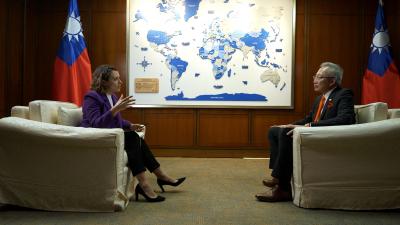Taiwanese researchers have developed a potential alternative to atropine eye drops that could cure childhood pseudomyopia without the side effects from atropine use.
The experimental eye drops, which last year received the National Innovation Award, use ribonucleic acid (RNA) interference to reverse childhood myopia and are scheduled to begin clinical trials late next year.
Controlling pseudomyopia — a precursor to myopia — is an important task in preventive medicine, Juo Suh-hang (卓夙航), head of the research project and a professor at China Medical University’s Institute of New Drug Development, said on Monday.
While myopia’s effect on vision can be corrected, surgical procedures do not lessen the risks of retinal detachment, macular degeneration and glaucoma that accompany severe myopia in middle-aged or older people, Juo said.
The most commonly prescribed eye drops for pseudomyopia contain the active ingredient atropine, he said.
However, atropine induces pupil dilation, which causes light sensitivity, blurry vision and increased susceptibility to eye damage from ultraviolet rays, he added.
As the groups most likely to receive treatment for pseudomyopia are school-aged children and adolescents, such side effects are amplified by prolonged periods of study and outdoor activities, Juo said.
To find an alternative for atropine, his team turned to genetics and found that people with myopia have an excessive amount of microRNA-328, he said.
Rather than suppress the secretion of microRNA-328 — which could alter the patient’s genes — the team developed a synthetic substance that neutralizes microRNA-328 and inhibits gene expression, a technique known as RNA interference, he said.
Animal trials have shown the experimental drug to be three to four times more effective than atropine and capable of reversing myopic eye axis elongation, while avoiding the side effects caused by atropine-induced pupil dilation, Juo said.
Research data suggest that the drug could completely cure pseudomyopia in children with vision equal to or better than minus-5 diopter, while halting myopic progression in children with worse vision and adults, he said.
Should the new drug pass human trials, it would be commercialized in seven to eight years, he added.

“China is preparing to invade Taiwan,” Deputy Minister of Foreign Affairs Francois Wu (吳志中) said in an exclusive interview with British media channel Sky News for a special report titled, “Is Taiwan ready for a Chinese invasion?” the Ministry of Foreign Affairs said today in a statement. The 25-minute-long special report by Helen Ann-Smith released yesterday saw Sky News travel to Penghu, Taoyuan and Taipei to discuss the possibility of a Chinese invasion and how Taiwan is preparing for an attack. The film observed emergency response drills, interviewed baseball fans at the Taipei Dome on their views of US President

ECONOMIC BENEFITS: The imports from Belize would replace those from Honduras, whose shrimp exports have dropped 67 percent since cutting ties in 2023 Maintaining ties with Taiwan has economic benefits, Ministry of Foreign Affairs officials said yesterday, citing the approval of frozen whiteleg shrimp imports from Belize by the Food and Drug Administration (FDA) as an example. The FDA on Wednesday approved the tariff-free imports from Belize after the whiteleg shrimp passed the Systematic Inspection of Imported Food, which would continue to boost mutual trade, the ministry said. Taiwan’s annual consumption of whiteleg shrimps stands at 30,000 tonnes, far exceeding domestic production, the ministry said. Taiwan used to fill the gap by importing shrimps from Honduras, but purchases slumped after Tegucigalpa severed diplomatic ties with Taiwan

The Executive Yuan yesterday approved a southwestern extension of the Sanying MRT Line from New Taipei to Bade District (八德) in Taoyuan, with a goal of starting construction by late 2026. The 4.03-kilometer extension, featuring three new stations, will run from the current terminus at Yingtao Fude Station (LB12) in New Taipei City to Dannan Station (LB14), where it will connect with Taoyuan’s Green Line, New Taipei City Metro Corp said in a statement. This extension will follow the completion of core Sanying Line, a 14.29-kilometer medium-capacity system linking Tucheng (土城), Sansia (三峽)

CARGO LOSS: About 50 containers at the stern of the ‘Ever Lunar’ cargo ship went overboard, prompting the temporary closure of the port and disrupting operations Evergreen Marine Corp, Taiwan’s largest container shipper, yesterday said that all crew members aboard the Ever Lunar (長月) were safe after dozens of containers fell overboard off the coast of Peru the previous day. The incident occurred at 9:40am on Friday as the Ever Lunar was anchored and waiting to enter the Port of Callao when it suddenly experienced severe rolling, Evergreen said in a statement. The rolling, which caused the containers to fall, might have been caused by factors including a tsunami triggered by an earthquake in Russia, poor winter sea conditions in South America or a sudden influx of waves,